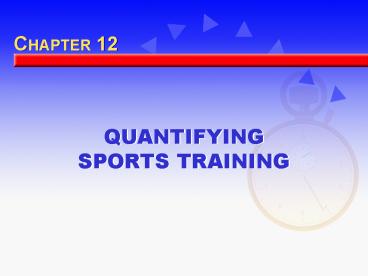Learning Objectives PowerPoint PPT Presentation
1 / 30
Title: Learning Objectives
1
(No Transcript)
2
Learning Objectives
w Review the factors that dictate the demands of
training volume and intensity.
w Learn the causes, signs, and treatment of
overtraining syndrome.
3
Learning Objectives
w Discover the strength, power, cardiovascular,
and muscular endurance changes that occur due to
detraining, inactivity, or total muscle
mobilization.
w Find out how to reduce training while
preventing a decline in long-term endurance and
aerobic capacity.
4
Did You Know?
A persons rate of adaptation and response to
training depends on that individual. He or she
cannot be forced beyond his or her bodys
capacity for development. Thus, training programs
must take these individual differences into
account.
5
Optimal Training Load
Progressive overloadprogressive increase in
training load as body adapts
Training volumeduration or frequency
Rest periodswithout them muscles become
chronically depleted
6
CHANGES IN HEART RATE AND BLOOD LACTATE
7
Did You Know?
The need for long daily workouts may not be the
best training method for some sports. It appears
that training volume could be reduced by as much
as one half in some sports, without reducing the
training benefits and with less risk of
overloading.
8
Symptoms of Overtraining Syndrome
w Decline in physical performance
w Decreased appetite and body weight loss
w Muscle tenderness
w Head colds, allergic reactions, or both
w Occasional nausea
w Sleep disturbances
w Elevated resting heart rate
w Elevated blood pressure
w Emotional instability
9
Possible Causes of Overtraining
w Periods of excessive training or emotional
stress
w Abnormal responses in the autonomic nervous
system
w Disturbances in endocrine function
w Depressed immune function
10
TRAINING VOLUME AND RISK OF INFECTION
11
Predicting Overtraining
w Increase in oxygen consumption (though
impractical for coach to measure)
w Heart rate response to standard bout of work
w Declines in performance
12
(No Transcript)
13
HEART RATE RESPONSES TO TRAINING
14
Treatment of Overtraining
w Reduce training intensity for several days
w Rest completely for three to five days
w Seek counseling
w Prevent overtraining by alternating easy,
moderate, and hard training
w Eat sufficient carbohydrate to prevent glycogen
depletion
15
Key Points
Training Demands
w Excessive training refers to training with an
unnecessarily high volume or intensity.
w Excessive training does not lead to additional
gains in performance and can lead to overtraining.
16
Key Points
Training Demands
w Training intensity can determine specific
adaptations to training.
w High-intensity, low-volume training increases
muscle strength and speed.
17
Key Points
Overtraining
w Overtraining leads to decreased performance
capacity.
w Symptoms of overtraining may occur briefly with
regular training.
w Overtraining may be caused by abnormal
responses in the autonomic nervous and endocrine
systems and suppressed immune function.
w Heart rate response appears to be the most
reliable warning of overtraining.
w Overtraining syndrome is treated most
effectively with rest and proper nutrition.
18
Did You Know?
Tapering for competition involves a reduction in
training intensity and volume. This rest allows
your body to repair itself and restore its energy
reserves to prepare you for your best performance.
19
Effects of Properly Tapering
w Muscular strength increases
w Energy reserves are restored
w Performance increases (especially in swimmers)
20
Detraining
w Cessation of regular training may be due to
inactivity or immobilization
w Loss of muscle size, strength, and power
w Decrease in muscular and cardiorespiratory
endurance
w Loss of speed, agility, and flexibility
21
Loss of Muscle Strength
w Muscle atrophy accounts for a loss in
development of maximal muscle fiber tension.
w Normal fiber recruitment is disrupted some
fibers are unable to be recruited.
w Muscle requires minimal stimulation (training
once every 10 to 14 days) to retain training
gains.
22
STRENGTH CHANGES WITH DETRAINING
23
Loss of Muscular Endurance
w Decreased performance may be related to losses
in cardiorespiratory endurance.
w Oxidative enzyme activity in muscles decreases.
w Glycolytic enzymes remain unchanged with up to
84 days of detraining.
w Muscle glycogen content (and thus storage
capacity) decreases.
w Acid-base balance becomes disturbed.
w Muscle capillary supply and fiber type may
change.
24
(No Transcript)
25
DETRAINING AND MUSCLE GLYCOGEN
26
Loss of Cardiorespiratory Endurance
w Losses are greatest in highly trained
individuals.
w Plasma volume decreases
w Stroke volume decreases
w Endurance performance decreases
27
Did You Know?
28
(No Transcript)
29
Retraining
w Recovery of conditioning after a period of
activity.
w Affected by fitness level and the length and
extent of inactivity.
w If a cast allows some range of movement,
retraining time can be reduced.
w Electrical stimulation of muscles can prevent
muscle fiber atrophy.
30
Key Points
Detraining and Retraining
w Detraining is the cessation of regular physical
training
w Retraining is resuming training after a period
of inactivity.
w The greater the training gains achieved, the
greater the losses with detraining.
w Detraining results in losses of muscle size,
strength, power, and endurance speed, agility,
and flexibility and cardiorespiratory endurance.

